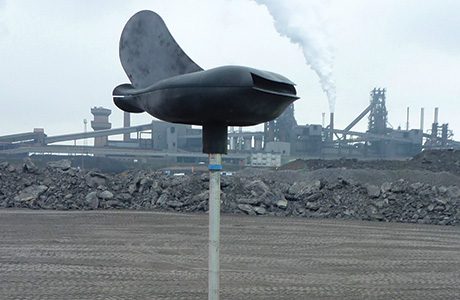
INDUSTRIAL sites and highways could become cleaner in the future thanks to shark-shaped samplers that hunt ‘fugitive’ air pollutants.
Scientists at Lancaster University and the Environment Agency are working together to develop a new sampler to measure levels of so-called fugitive pollutants – such as particulates, and gases such as ammonia and nitrogen dioxide.
‘Directional Passive Air Quality Samplers’, which look similar to basking sharks and have been patented as part of ongoing research, are able to monitor the levels of pollutants that are caused by industrial activity, or traffic. The sources of these pollutants, such as airborne particles thrown up by transportation or extraction of raw materials, and intensive agriculture, cannot be identified by standard fixed integrated monitors.
Due to environmental regulations as part of industrial permits, operators need to install controls – such as dampening of road surfaces to keep down dust, and the fitting of wind shields to conveyors – to reduce fugitive pollutants. However, this is not currently done on a targeted basis, and is therefore inefficient, due to the lack of suitable monitors that can pinpoint the direction of pollution sources.

Intent behind the research
Dr Maria Angeles Solera García, senior research associate at Lancaster University, said: “Industrial site operators, in order to comply with the permits issued by regulators, put in numerous costly control measures to tackle fugitive air pollutants in these complex environments. However, these are mostly untargeted as they do not have access to the evidence that more mobile and cost-effective monitors may provide. This is what our research is looking to achieve.
“At Lancaster University, in partnership with the Environment Agency, we are developing monitors that are easily deployable in the field, that do not require a power source and are affordable. This will enable operators to more efficiently target their resources on effective controls to reduce the volume of fugitive pollutants in the environment.”
The problem with conventional monitors
Although there are existing monitors on the market, they are costly, bulky and require a power source and are therefore not easily deployable.
The Directional Passive Air Quality Sampler, whose shark-like shape was developed with help from the Lancaster Product Development Unit in Lancaster University’s Engineering Department, pivots in the wind to capture wind-blown pollutants through its ‘mouth’. The monitor contains 12 vials in a static carousel that collects samples from different directions for analysis. The sampler can be left in position for a month without additional supervision.
The Directional Passive Air Quality Samplers have been successfully field tested at several situations, including an anaerobic digester in Scotland, a steel works in Yorkshire, and the roadside at a busy highway.
Professor Roger Timmis, lead Environment Agency scientist for the project and co-inventor, said: “The Directional Passive Air Quality Sampler (DPAS) is a successful collaboration between LEC and the Environment Agency’s Evidence Directorate. By using the DPAS to resolve sources of air pollution we can regulate them more effectively to protect people and the environment.”
The future
The research is now attracting the interest of environment regulators in the United State, who need to monitor air pollution in similar situations, such as roadways or ports.
The project has received funding until 2016 and will see additional revisions to hone the design and functionality of the sampler before it is ready for commercial use.
More information about the Lancaster Environment Centre is available by visiting http://www.lancaster.ac.uk/lec/
Information about the Lancaster Product Development Unit, which is supported by the European Regional Development Fund (ERDF) with some additional funding coming from the Engineering and Physical Sciences Research Council (EPSRC), can be found here http://www.lpdu.lancs.ac.uk/
To find out more about Lancaster University visit www.lancaster.ac.uk






